Showing Spotlights 177 - 184 of 237 in category All (newest first):
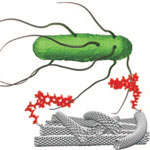 In their effort to develop a fast, sensitive, selective, inexpensive, and easy-to-use method for detecting and quantifying pathogenic bacterial cells, researchers in Spain have now demonstrated a carbon nanotube based potentiometric biosensor for selectively detecting one single colony-forming unit of the bacterium Salmonella Typhi in close to real time. The most important strength of this biosensor is that simple positive/negative tests can be carried out in real zero-tolerance conditions and without cross reaction with other types of bacteria. The ease with which measurements are taken in potentiometric analysis opens the door to greater simplicity in microbiological analysis.
In their effort to develop a fast, sensitive, selective, inexpensive, and easy-to-use method for detecting and quantifying pathogenic bacterial cells, researchers in Spain have now demonstrated a carbon nanotube based potentiometric biosensor for selectively detecting one single colony-forming unit of the bacterium Salmonella Typhi in close to real time. The most important strength of this biosensor is that simple positive/negative tests can be carried out in real zero-tolerance conditions and without cross reaction with other types of bacteria. The ease with which measurements are taken in potentiometric analysis opens the door to greater simplicity in microbiological analysis.
Oct 5th, 2009
 According to the World Health Organization, lung cancer is the leading cancer-related cause of death, accounting for 18 percent of cancer deaths and killing about 1.3 million people worldwide every year. Conventional diagnostic methods for lung cancer occasionally miss tumors and they are costly and unsuitable for widespread screening. Breath testing is a fast, non-invasive diagnostic method that links specific volatile organic compounds (VOCs) in exhaled breath to medical conditions. However, these techniques - gas chromatography/mass spectrometry, ion flow tube mass spectrometry, laser absorption spectrometry, infrared spectroscopy, polymer-coated surface acoustic wave sensors and coated quartz crystal microbalance sensors - are expensive, slow, and require complex instruments. A multidisciplinary research team at Technion - Israel Institute of Technology have now demonstrated a highly sensitive, stable, relatively inexpensive, and fast-response nine-sensor array that consists of gold nanoparticles functionalized with different organic groups that respond to various VOCs that are relevant to lung cancer.
According to the World Health Organization, lung cancer is the leading cancer-related cause of death, accounting for 18 percent of cancer deaths and killing about 1.3 million people worldwide every year. Conventional diagnostic methods for lung cancer occasionally miss tumors and they are costly and unsuitable for widespread screening. Breath testing is a fast, non-invasive diagnostic method that links specific volatile organic compounds (VOCs) in exhaled breath to medical conditions. However, these techniques - gas chromatography/mass spectrometry, ion flow tube mass spectrometry, laser absorption spectrometry, infrared spectroscopy, polymer-coated surface acoustic wave sensors and coated quartz crystal microbalance sensors - are expensive, slow, and require complex instruments. A multidisciplinary research team at Technion - Israel Institute of Technology have now demonstrated a highly sensitive, stable, relatively inexpensive, and fast-response nine-sensor array that consists of gold nanoparticles functionalized with different organic groups that respond to various VOCs that are relevant to lung cancer.
Aug 31st, 2009
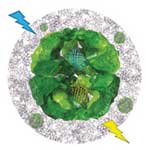 The term bio-interface describes the boundary between synthetic materials such as plastics, and biological systems. This rapidly growing research area, where biology and material sciences overlap, is creating new opportunities for the design, synthesis, and optimization of biologically-enabled and biologically-inspired materials. It involves manufacturing and characterization of functional surfaces for specific interactions with bio-systems and studies of the molecular and kinetic processes occurring at such interfaces, ranging from small molecule and biomolecular interactions, to cell adhesion, differentiation and tissue formation at the interface. For example, the incorporation of proteins into polymers can result in hybrid materials that combine the properties of the polymer as a cost-effective and easy to process material with the highly evolved biological functionality of the protein, enabling new concepts for construction of sensors and biomedical materials. While researchers so far have been focusing on altering the properties of a polymer by adding the functionality of a biomolecule, a group in California has now demonstrated the reverse situation, where changes in the polymer can alter the properties of the protein.
The term bio-interface describes the boundary between synthetic materials such as plastics, and biological systems. This rapidly growing research area, where biology and material sciences overlap, is creating new opportunities for the design, synthesis, and optimization of biologically-enabled and biologically-inspired materials. It involves manufacturing and characterization of functional surfaces for specific interactions with bio-systems and studies of the molecular and kinetic processes occurring at such interfaces, ranging from small molecule and biomolecular interactions, to cell adhesion, differentiation and tissue formation at the interface. For example, the incorporation of proteins into polymers can result in hybrid materials that combine the properties of the polymer as a cost-effective and easy to process material with the highly evolved biological functionality of the protein, enabling new concepts for construction of sensors and biomedical materials. While researchers so far have been focusing on altering the properties of a polymer by adding the functionality of a biomolecule, a group in California has now demonstrated the reverse situation, where changes in the polymer can alter the properties of the protein.
Aug 11th, 2009
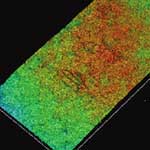 Developing bioassays that are simple, portable, disposable and inexpensive will provide important tools to rapidly detect toxic substances. This technology could also be extremely useful in monitoring environmental and food-based toxins in remote settings such as less industrialized countries where these tools are essential for the first stages of detecting disease settings and where the time and expense of using sophisticated instrumentation would be prohibitive. To that end, researchers have developed simple, portable, disposable, and inexpensive paper-based solid-phase sensors to run multiple bioassays and controls simultaneously. Bioactive paper is any low-cost and easy-to-use paper product laced with biologically active chemicals that provides a rapid way to detect toxins like E. coli bacteria and salmonella, or pathogens such as SARS or influenza.
Developing bioassays that are simple, portable, disposable and inexpensive will provide important tools to rapidly detect toxic substances. This technology could also be extremely useful in monitoring environmental and food-based toxins in remote settings such as less industrialized countries where these tools are essential for the first stages of detecting disease settings and where the time and expense of using sophisticated instrumentation would be prohibitive. To that end, researchers have developed simple, portable, disposable, and inexpensive paper-based solid-phase sensors to run multiple bioassays and controls simultaneously. Bioactive paper is any low-cost and easy-to-use paper product laced with biologically active chemicals that provides a rapid way to detect toxins like E. coli bacteria and salmonella, or pathogens such as SARS or influenza.
Jul 24th, 2009
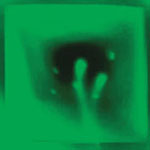 Controlling surface plasmons has become increasingly attractive for optical signal processing, surface enhanced spectroscopy and sensor nanotechnology. For instance, the role of surface plasmon resonance (SPR) on resonant transmission through nanohole arrays has motivated their application as surface-based biosensors. New work by a team of scientists in Canada has combined nanofluidics and nanoplasmonics for SPR sensing using flow-through nanohole arrays. This new format enables rapid transport of reactants to the active sensing surface and the array serves as a sieve. That is, the flow-through array efficiently collects and detects biomarkers from a very small volume of fluid.
Controlling surface plasmons has become increasingly attractive for optical signal processing, surface enhanced spectroscopy and sensor nanotechnology. For instance, the role of surface plasmon resonance (SPR) on resonant transmission through nanohole arrays has motivated their application as surface-based biosensors. New work by a team of scientists in Canada has combined nanofluidics and nanoplasmonics for SPR sensing using flow-through nanohole arrays. This new format enables rapid transport of reactants to the active sensing surface and the array serves as a sieve. That is, the flow-through array efficiently collects and detects biomarkers from a very small volume of fluid.
Jul 17th, 2009
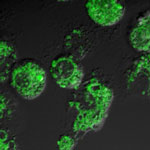 Environmental and behavioral factors may lead the body to produce superoxide radicals known as reactive oxygen species (ROS) that could cause cell damage through oxidation. Oxidative stress from ROS is implicated in aging and most diseases including cancer, heart disease, liver fibrosis, neurodegenerative diseases, autoimmune disorders. An excess of these reactive molecules can lead to oxidative stress and cellular damage, and toxicologists have identified ROS generation as a likely mechanism of nanoparticle toxicity. Since ROS plays an important role in various pathogenic processes, it has been recognized as an early indicator for cytotoxic events and cellular disorders. However, conventional chemical ROS probes have not fulfilled the rising need of in vitro and in vivo analysis of ROS generation due to auto-oxidation problems and poor specificity and sensitivity. Scientists in South Korea have now demonstrated a novel ROS-sensitive gold nanoprobe prepared from bio-inspired immobilization of fluorescein-labeled hyaluronic acid onto the surface of gold nanoparticles. This probe is highly stable under exposure to natural light and laser sources and extremely sensitive and specific to certain oxygen species.
Environmental and behavioral factors may lead the body to produce superoxide radicals known as reactive oxygen species (ROS) that could cause cell damage through oxidation. Oxidative stress from ROS is implicated in aging and most diseases including cancer, heart disease, liver fibrosis, neurodegenerative diseases, autoimmune disorders. An excess of these reactive molecules can lead to oxidative stress and cellular damage, and toxicologists have identified ROS generation as a likely mechanism of nanoparticle toxicity. Since ROS plays an important role in various pathogenic processes, it has been recognized as an early indicator for cytotoxic events and cellular disorders. However, conventional chemical ROS probes have not fulfilled the rising need of in vitro and in vivo analysis of ROS generation due to auto-oxidation problems and poor specificity and sensitivity. Scientists in South Korea have now demonstrated a novel ROS-sensitive gold nanoprobe prepared from bio-inspired immobilization of fluorescein-labeled hyaluronic acid onto the surface of gold nanoparticles. This probe is highly stable under exposure to natural light and laser sources and extremely sensitive and specific to certain oxygen species.
Jul 2nd, 2009
 Gas sensing applications are numerous in our modern society and include process monitoring, environmental compliance, health applications, homeland security, agriculture, etc. Gas sensors often operate by detecting the subtle changes that deposited gas molecules make in the way electricity moves through a surface layer. Thus, the more surface available, the more sensitive the sensor will be. Nanoscale materials are intriguing materials for next-generation nanotechnology gas sensors since their relative surface areas are so large. A problem with existing gas nanosensors is the cross-interference of other gas analytes. For instance, carbon nanotube based gas sensors for the prominent air pollutant nitrogen dioxide have shown strong interference of ethanol and ammonia gases to the NO2 response. Another cross-interference often is caused by humidity, i.e. the water vapor in the air. New research now demonstrates how the manufacturing of a nanosensor for ammonia gas can be tuned to eliminate the interference of water vapor. The trick lies in accurately controlling the synthesis of the sensing nanomaterial.
Gas sensing applications are numerous in our modern society and include process monitoring, environmental compliance, health applications, homeland security, agriculture, etc. Gas sensors often operate by detecting the subtle changes that deposited gas molecules make in the way electricity moves through a surface layer. Thus, the more surface available, the more sensitive the sensor will be. Nanoscale materials are intriguing materials for next-generation nanotechnology gas sensors since their relative surface areas are so large. A problem with existing gas nanosensors is the cross-interference of other gas analytes. For instance, carbon nanotube based gas sensors for the prominent air pollutant nitrogen dioxide have shown strong interference of ethanol and ammonia gases to the NO2 response. Another cross-interference often is caused by humidity, i.e. the water vapor in the air. New research now demonstrates how the manufacturing of a nanosensor for ammonia gas can be tuned to eliminate the interference of water vapor. The trick lies in accurately controlling the synthesis of the sensing nanomaterial.
Jun 23rd, 2009
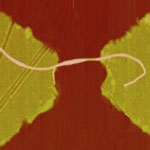 Infrared (IR) detectors are used in imaging applications that include for instance medical diagnosis, environmental monitoring, space science, and security and military sensor devices. High-quality detectors require cryogenic cooling in order for the image not to be distorted by the detectors own radiation. This makes them expensive both to produce and to run. Although uncooled IR detectors are made, their resolution and image quality tend to be much lower than cooled detectors. It appears that carbon nanotubes (CNTs) could be used as novel IR detector material that would allow the fabrication of highly efficient detectors that do not require cooling. Researchers at Michigan State University have now, for the first time, experimentally demonstrated the design, manufacturing and experimental testing of an integrated nanoantenna concept for CNT based IR sensors.
Infrared (IR) detectors are used in imaging applications that include for instance medical diagnosis, environmental monitoring, space science, and security and military sensor devices. High-quality detectors require cryogenic cooling in order for the image not to be distorted by the detectors own radiation. This makes them expensive both to produce and to run. Although uncooled IR detectors are made, their resolution and image quality tend to be much lower than cooled detectors. It appears that carbon nanotubes (CNTs) could be used as novel IR detector material that would allow the fabrication of highly efficient detectors that do not require cooling. Researchers at Michigan State University have now, for the first time, experimentally demonstrated the design, manufacturing and experimental testing of an integrated nanoantenna concept for CNT based IR sensors.
Apr 22nd, 2009
 In their effort to develop a fast, sensitive, selective, inexpensive, and easy-to-use method for detecting and quantifying pathogenic bacterial cells, researchers in Spain have now demonstrated a carbon nanotube based potentiometric biosensor for selectively detecting one single colony-forming unit of the bacterium Salmonella Typhi in close to real time. The most important strength of this biosensor is that simple positive/negative tests can be carried out in real zero-tolerance conditions and without cross reaction with other types of bacteria. The ease with which measurements are taken in potentiometric analysis opens the door to greater simplicity in microbiological analysis.
In their effort to develop a fast, sensitive, selective, inexpensive, and easy-to-use method for detecting and quantifying pathogenic bacterial cells, researchers in Spain have now demonstrated a carbon nanotube based potentiometric biosensor for selectively detecting one single colony-forming unit of the bacterium Salmonella Typhi in close to real time. The most important strength of this biosensor is that simple positive/negative tests can be carried out in real zero-tolerance conditions and without cross reaction with other types of bacteria. The ease with which measurements are taken in potentiometric analysis opens the door to greater simplicity in microbiological analysis.
 Subscribe to our Nanotechnology Spotlight feed
Subscribe to our Nanotechnology Spotlight feed





